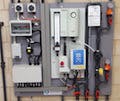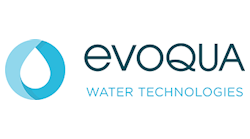Daryl Weatherup, director of marketing for Wallace & Tiernan, an Evoqua Brand, discusses chlorination and how the technology has evolved over the years.
WaterWorld: Chlorine sometimes gets a bad rap; do you think it gets the reputation it deserves?
Daryl Weatherup: There are really two sides to the story. For over a hundred years, chlorine has been the most widely used method for disinfecting water, not only in the U.S. but around the world. So, it's got a great reputation for improving human health and sanitation, and helping to eliminate or eradicate waterborne diseases.
But there is another side to it that contributes to that bad reputation -- if there's a chemical release or a spill, for example. Also, sometimes it can be misused or misapplied, and therefore, in those instances, too much chlorine -- or too much of any strong disinfectant -- can sometimes be lethal to human or natural life. So, in that case, there is a level of concern about the safety of chlorination and how it should be handled and applied.
WW: What kinds of advances -- whether a process or technology -- have made chlorination safer?
DW: Chlorination has come a long way. We started out at Wallace & Tiernan with the first commercial chlorinator in 1913, and since then have improved the process and the technology considerably. Two factors have helped us achieve that: one is advances in design tools such as CAD software and other modeling software. Things like that, of course, weren’t available back then. The other factor is the technology and the materials that are available today. We now have engineered plastics, composites, synthetic elastomers and special metal alloys that are better at withstanding strong oxidants like chlorine, and so we use those materials to improve the quality of the products.
There are other ancillary components and subsystems that make up the total chlorination system, and those are things like non-isolating switchover valves, safety shut-off valves, and a secondary protection system. An example of that would be what's called an emergency vapor scrubber system (EVSS), which is a system that is manufactured by Evoqua. We employ those and customers use them as a backup in case of a release of the chlorine container, whether it’s one of the smaller, up to 150-lb. cylinders, up to a full one-ton container, or even a railcar size. That scrubber system will start up automatically in the event that a chlorine leak is detected and scrub the chlorine gas out of the air and put it safely into solution so that it can be discarded.
In addition to that there are things like gas detection systems that we manufacture as well as things like fire safety doors, SCBA packs, and other items that can help make the total chlorination system much safer today than it was even a decade ago.
WW: What are some alternatives methods of chlorination?
DW: That's a good question. There are really four alternative methods of chlorination, or formats, as we would call them. The one that is most widely used -- and has been used for the longest time -- is one that we have already talked about: chlorine gas.
But it's also available in a liquid format. That's known as sodium hypochlorite, or the household name would be bleach. That’s the same bleach that you use for laundry or for cleaning but the type used for households is a lower concentration than the commercial grade.
The third one would be dry, calcium hypochlorite tablets or pellets. Those are also typically used in household swimming pools and you see them in the hardware store.
And then there is the fourth method: onsite generation. That's an electrochemical process that takes saltwater or brine solution and makes chlorine out of it through electricity. So those are the four methods of chlorination.
WW: What about disinfection methods that don't involve chlorine?
DW: There are other methods for disinfection that are sometimes seen as alternatives to chlorination, like UV or ozone, but the one difference between chlorination and those is that chlorination actually provides a residual disinfectant, which is required by US EPA to maintain stability and disinfection in the water as it gets transferred from water treatment plants to the end customer.
WW: So, if a water utility is trying to decide on which chlorination method is best for them, how can they go about making that decision?
DW: It really comes down to a local decision that should take into account several different factors aside from just capital cost of the equipment or the operating costs of the chlorination solution. We would advise taking into account, first of all, the location of the plant. Is it in a rural area? Is it in an urban area? Are there any surrounding environmental concerns? What is the access to the plant for the chemical deliveries and what's the frequency of the deliveries?
Another economic decision driver is the distance from the nearest supplier of the chemical -- whether it's chlorine or bleach or the salt used to make hypochlorite on site. We take that into account because chlorine gas is compressed, transported and delivered at 100% strength in the container to the water plant.
Bleach, on the other hand, is much more dilute. The commercial strength of bleach is up to 15%, which means that 85% or more of the solution being delivered is water. If the plant is close to the point of production or where the chemical is manufactured, that's usually not a big factor, but if it’s a good distance away, you can imagine that the cost to deliver that chemical to the plant is much higher. In those cases, either chlorine gas or onsite generation from salt may be more cost effective.
WW: Are they any other factors that are important to consider?
DW: Yes, there are a couple other factors, like water quality or the disinfection goals of the treatment process. If you look at the stability of the chemicals, sodium hypochlorite degrades over time with respect to temperature and as it degrades, it can generate some unwanted byproducts. So, it's important to look at the rate of consumption of chemicals and that's with respect to the flow rate and how much disinfectant, or what's called chlorine demand, is needed for the application.
WW: So it's safe to say that there isn't a one-size-fits-all approach?
DW: Exactly. There really isn’t any one solution that you could recommend across the board for a certain type of process or a certain size of water treatment application. It really has to be a local decision, and it can sometimes be difficult for a water utility to make that decision on their own, and so they might consult for some additional advice.
WW: Who could a water utility reach out to?
DW: Well, they could talk to a manufacturer, such as Evoqua, somebody who offers all four types of chlorination equipment -- as well as UV and alternative disinfectants -- who can give some well-balanced guidance. I would be advised when talking with a manufacturer that makes only one offering because you might get a biased view. But additionally, there are consulting engineers who specialize in providing this type of assistance and in the selection of chlorination methods or disinfection methods.
And on top of that, there are also handbooks and guidelines published by the EPA and AWWA that offer really good information about selecting disinfectants.
WW: How do you respond to people who say that chlorine is dangerous and should not be used?
DW: I would say anything can be dangerous when it's mishandled or used improperly. And actually, a municipal water treatment plant is one of the safest places where chlorine is used. One aspect that is outside of our control is the transportation of chemicals, so between the manufacturing plant and point of application. That is oftentimes where an incident or a spill may occur and there is nothing that we in the water industry can really do about that. As for chlorine in the municipal water treatment plant -- even today, after 100 years, it is by far the safest, most reliable, most widely used form of disinfection.




